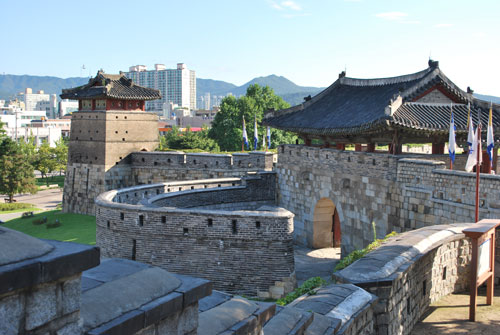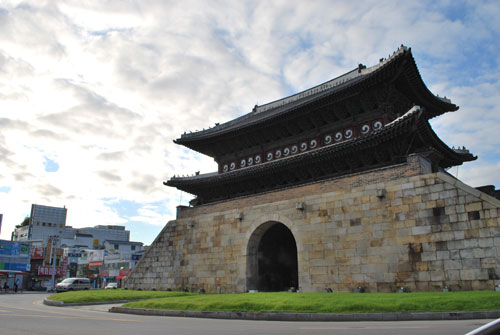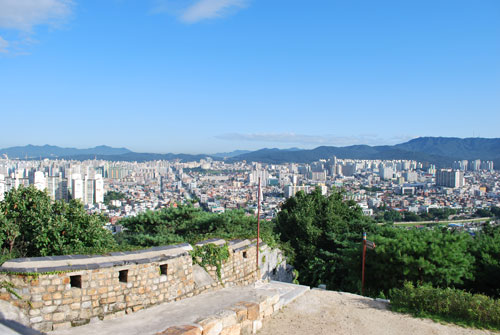 Hwaseomun Gate (화서문) is the western gate of Hwaseong Fortress.
Hwaseomun Gate (화서문) is the western gate of Hwaseong Fortress.
South Korea’s efficient transportation network makes exploring the country cheap and easy. And although Korea is relatively small, trekking to Busan or Jeju Island is definitely more than a day trip. But thankfully there are plenty of great sites that are just an hour or two from Seoul.
In terms of day trips, I can’t think of a better place than Hwaseong Fortress (수원화성) in the Gyeonggi Province city of Suwon. Although it’s less than an hour from Seoul via metro line one, I had yet to see it for myself. So, last summer I went there.
 Seojangdae (서장대) is one of two command posts at the Fortress. The inscription of the hanging board on the western post (above) was written by King Jeongjo. The stone structure to the right is Seonodae (서노대). The octagonal crossbow tower is one of two.
Seojangdae (서장대) is one of two command posts at the Fortress. The inscription of the hanging board on the western post (above) was written by King Jeongjo. The stone structure to the right is Seonodae (서노대). The octagonal crossbow tower is one of two.
In 1997 when the United Nations designated Hwaseong Fortress a part of the world’s cultural heritage, they cited its unique blend of eastern and western architectural styles. Completed in 1796 by the great Joseon Dynasty king, Jeongjo (1752-1800), its construction was inspired by the 16th century Japanese invasions, which destroyed most of Korea’s grand palaces and temples.
 A map of the area encompassed by the Fortress’s 5.7-kilometers of walls. The red circle indicates Hwaseong Haenggung (화성행궁), the king’s detached palace.
A map of the area encompassed by the Fortress’s 5.7-kilometers of walls. The red circle indicates Hwaseong Haenggung (화성행궁), the king’s detached palace.
In a break with the past, Hwaseong was designed to protect both a temporary palace for the king and a village from foreign invaders, by means of a 5.7-kilometer long, 5-meter high fortress wall. But while Hwaseong features the stone walls, sentry towers and turrets of a military stronghold, it’s also enhanced by the delicate and colorful architecture typical of Joseon-era palaces. The result is an unusually harmonious integration of styles.
 King Jeongjo (right) created Hwaseong Fortress to honor his father, Prince Sado, who was killed on order of his grandfather, King Yeongjo (left).
King Jeongjo (right) created Hwaseong Fortress to honor his father, Prince Sado, who was killed on order of his grandfather, King Yeongjo (left).
It’s been said that the fortress was part of King Jeongjo’s plan to move the capital away from Seoul. Why the move, you ask? Well, Seoul bore bad memories for the king, whose father, Prince Sado, was murdered by his grandfather, King Yeongjo. Upon hearing that Sado was mentally ill and indiscriminately killing people, Yeongjo locked the prince in a rice chest for eight days until he died. As a result, Jeongjo spent much of his reign trying to repair his father’s legacy. If he moved the capital to Suwon, the new king could escape the fractious strife of Seoul palace life, he would be closer to his father’s grave, and he could realize his reformist agenda.
 “Posas” like this one are sentry posts where warning signals were sent during enemy attacks.
“Posas” like this one are sentry posts where warning signals were sent during enemy attacks.
King Jeongjo is remembered as a visionary whose reign was a renaissance for Joseon-era Korea. Silhak (실학), a new school of philosophy that emphasized scientific and practical learning, helped Jeongjo launch both progressive social and technological innovations. For example, the citizens who built Hwaseong were paid, and new inventions, including a machine that could lift over seven tons, were employed.
 Paldalmun (팔달문) is Hwaseong Fortress’s southern gate. Construction began in 1794. During the Joseon Dynasty, it was the gateway used by processions to Hyeollyungwon (현륭원), which is the tomb of Prince Sado.
Paldalmun (팔달문) is Hwaseong Fortress’s southern gate. Construction began in 1794. During the Joseon Dynasty, it was the gateway used by processions to Hyeollyungwon (현륭원), which is the tomb of Prince Sado.
Despite two centuries of war and conquest, about 75% of the fortress wall remains. If you walk there from the Suwon train station, you’ll reach Paldalmun (팔달문) first. The name of the fortress’s 2-story tall south gate means, “gate open in all directions.” The north gate, or Janganmun (장안문), is the largest gate ever built in Korea. Destroyed during the Korean War, it was rebuilt in 1979. Both gates are surrounded by an ongseong (옹성), which is a protective stone semicircle.
 The graceful Hwahongmun (화홍문) spans the Hwaseong stream, which flows through the enclosed city.
The graceful Hwahongmun (화홍문) spans the Hwaseong stream, which flows through the enclosed city.
41 of the wall’s original 48 watchtowers, gates and pavilions also remain. One of my two favorites is Hwahongmun (화홍문), a graceful pavilion set atop seven stone arches with the Hwaseong stream flowing underneath.
 The Fortress’s northwest observation tower is among the most impressive parts of the wall.
The Fortress’s northwest observation tower is among the most impressive parts of the wall.
Seobuk Gongsimdon (서북 공심돈) is my other favorite. The northwest observation tower’s impressive stone and brick edifice is peppered with holes for cannons and archers.
 The temporary palace’s main audience hall is named Bongsudang (봉수당). Used for royal visits, the name means a “wish for ten thousand years of healthy life.”
The temporary palace’s main audience hall is named Bongsudang (봉수당). Used for royal visits, the name means a “wish for ten thousand years of healthy life.”
If you follow the stream, at the foot of Mount Paldal you’ll find Hwaseong Haenggung (화성 행궁), the largest of the Joseon temporary palaces. At its height, the palace included 576 compartments that featured feasts and cultural performances. It was destroyed during the Japanese occupation, but restoration started in 1996 and should be complete by 2010. Adjacent to it is the Hwaryeongjeon (화령전) where Jeongjo’s spirit and portrait are enshrined.
 Despite its primary function as a protective barrier, Hwaseong Fortress also includes serene and beautiful places.
Despite its primary function as a protective barrier, Hwaseong Fortress also includes serene and beautiful places.
Because Hwaseong was built in honor of his father, many Koreans see the fortress as a monument to filial piety, which is a Confucian-inspired love and respect for one’s family and ancestors. To this end, students come here each April to feast and celebrate their elders.
 An ancient tree located on the grounds of the detached palace.
An ancient tree located on the grounds of the detached palace.
But that’s not the only attraction. Visitors can try their hand with a bow and arrow at an on-site archery range, and every Sunday from May to November, a traditional military ceremony is performed by costumed soldiers. If that’s not enough, on October 11th, a citizen’s parade will follow a reenactment of King Jeongjo’s royal tomb visit. No word yet if the procession will match the 5,661 people and 1,417 horses of Jeongjo’s original!
 One of the best aspects of the Fortress is the panoramic views afforded to hikers.
One of the best aspects of the Fortress is the panoramic views afforded to hikers.
 Whenever you decide to go, know that all 5.7-kilometers of the fortress wall and its attractive grounds are open to the public and feature excellent English signage. And, since the wall covers both flat and hilly terrain, it makes for a great hike with scenic views of surrounding Suwon.
Whenever you decide to go, know that all 5.7-kilometers of the fortress wall and its attractive grounds are open to the public and feature excellent English signage. And, since the wall covers both flat and hilly terrain, it makes for a great hike with scenic views of surrounding Suwon.
Getting There:
→ From Seoul, take subway line 1 to Suwon Station (exit #1). The trip, which runs just over an hour, costs less than 2,000 won. After exiting the subway, walk northeast along the main road for about 1.5 kilometers. At the major intersection (Gyodong Sageori), veer left. After about 500 meters you should reach Paldal Gate. If you’re not up for the 2-kilometer walk, you can hail a taxi at the station.
→ New: Visit the full Hwaseong Fortress photo gallery here.
(A version of this text aired on KBS World Radio on August 30, 2008.)



Hi Matt,
I live in Suwon and I’ve been to the fortress many times. You took some really great pictures! Makes me want to go again and walk extra slow to dig the whole scene.
Keep up the good work! I love the website!
Simon
By: slandry04 on 29 April 2009
at 10:51
Hi Simon,
Thanks for your note. You’re lucky to live so close by. I was at the Fortress again just a week or two back with my dad and his wife. Unfortunately, she had a bum leg and the dragon train was sold out, which kind of nixed our sightseeing plan. Despite being not terribly good for people with mobility issues, it’s a great place, and I, too, will be back soon.
Oh, do you have any other suggestions for things to see or places to go in the greater Suwon/Gyeonggido area?
Thanks, Matt
By: Matt Kelley on 29 April 2009
at 10:58